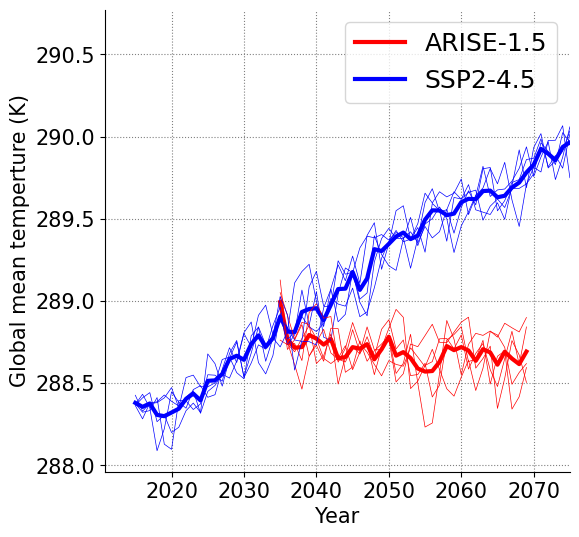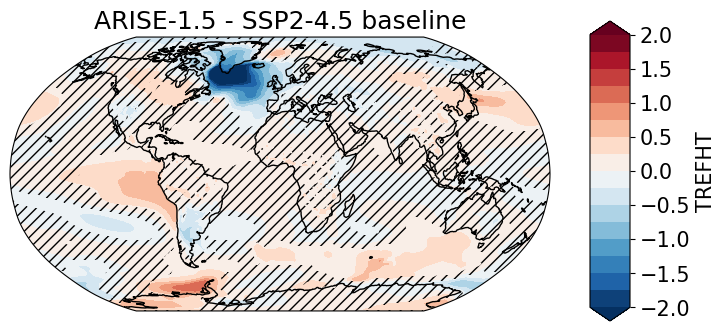Example usage of the AWS ARISE-1.5 data set#
Notebook shows how to access ARISE-1.5 CESM2-WACCM data hosted on AWS S3, compute aggregates and visualize results with xarray.
Goal: Compare near-surface air temperature TREFHT under ARISE-SAI-1.5 against the SSP2-4.5 background.
Steps:
Connect to the public S3 storage and open the netcdf files with xarray
Load the 5 available ensemble members for each scenario and concatenate them into a single dataset.
Convert monthly data into annual means and calculate global, area-weighted means
Calculate difference between ARISE and the SSP2 baseline and assess statistical significance
Make two plots showing the results
Time series line plot of global-mean
TREFHTfor ARISE-1.5 and SSP2-4.5A world map of ARISE-1.5 minus baseline
TREFHTwith significance hatching
Cloud access#
We use the s3fs, fsspec packages to mount the cloud repo to read from s3:// URLs.
Note as of Sunday 9th February 2025: the approach here is limited by needing to hard code file paths to the data. In theory, intake-esm should help with this, using the catalog here (NCAR/CESM2-ARISE). However, I couldn’t get this to work. Pull requests to improve this are welcome!
Data is here: https://aws.amazon.com/marketplace/pp/prodview-7r3ocbnp5exq2#overview https://registry.opendata.aws/ncar-cesm2-arise/
## packages for cloud data intake:
import s3fs
import fsspec
## packages for analysis
import pandas as pd
import xarray as xr
import numpy as np
import matplotlib.pyplot as plt
Test a single file from S3#
Open one monthly TREFHT file from the ARISE S3 bucket to validate access and decoding. We use xarray with an HDF5-based backend and anonymous S3 access.
## test reading in a file to a dataset:
loc = 'ncar-cesm2-arise/ARISE-SAI-1.5/b.e21.BW.f09_g17.SSP245-TSMLT-GAUSS-DEFAULT.001/atm/proc/tseries/month_1/b.e21.BW.f09_g17.SSP245-TSMLT-GAUSS-DEFAULT.001.cam.h0.TREFHT.203501-206912.nc'
s3_path = "s3://" + loc
# Open the dataset directly from the S3 URL using xarray
with fsspec.open(s3_path, mode='rb', anon=True) as file:
ds = xr.open_dataset(file, engine="h5netcdf")
ds['TREFHT']
<xarray.DataArray 'TREFHT' (time: 420, lat: 192, lon: 288)> Size: 93MB
[23224320 values with dtype=float32]
Coordinates:
* lat (lat) float64 2kB -90.0 -89.06 -88.12 -87.17 ... 88.12 89.06 90.0
* lon (lon) float64 2kB 0.0 1.25 2.5 3.75 5.0 ... 355.0 356.2 357.5 358.8
* time (time) object 3kB 2035-02-01 00:00:00 ... 2070-01-01 00:00:00
Attributes:
units: K
long_name: Reference height temperature
cell_methods: time: meanBuilding the ensemble dataset (multiple members in a single xarray dataset)#
Assemble multiple ensemble members into a single dataset with a new member_id dimension
def get_trefht_data(scenario='ARISE'):
ds_list = []
members = ['001', '002', '003', '004', '005']
for member in members:
locs = {'ARISE':'ncar-cesm2-arise/ARISE-SAI-1.5/b.e21.BW.f09_g17.SSP245-TSMLT-GAUSS-DEFAULT.{m}/atm/proc/tseries/month_1/b.e21.BW.f09_g17.SSP245-TSMLT-GAUSS-DEFAULT.{m}.cam.h0.TREFHT.203501-206912.nc'.format(m=member),
'SSP245_1':'ncar-cesm2-arise/CESM2-WACCM-SSP245/b.e21.BWSSP245cmip6.f09_g17.CMIP6-SSP2-4.5-WACCM.{m}/atm/proc/tseries/month_1/b.e21.BWSSP245cmip6.f09_g17.CMIP6-SSP2-4.5-WACCM.{m}.cam.h0.TREFHT.201501-206412.nc'.format(m=member),
'SSP245_2':'ncar-cesm2-arise/CESM2-WACCM-SSP245/b.e21.BWSSP245cmip6.f09_g17.CMIP6-SSP2-4.5-WACCM.{m}/atm/proc/tseries/month_1/b.e21.BWSSP245cmip6.f09_g17.CMIP6-SSP2-4.5-WACCM.{m}.cam.h0.TREFHT.206501-210012.nc'.format(m=member)}
loc = locs[scenario]
s3_path = "s3://" + loc
# Open the dataset directly from the S3 URL using xarray
with fsspec.open(s3_path, mode='rb', anon=True) as file:
ds = xr.open_dataset(file, engine="h5netcdf")
ds_list.append(ds.load())
# note that this takes a decent chunk of memory as we dont do anything clever with dask here
ds = xr.concat(ds_list, dim='member_id').assign_coords({'member_id':members})
ds = ds['TREFHT'].to_dataset(name='TREFHT') ## drop extra variables
return ds
For SSP2-4.5, the data comes split across two files (early and late periods) so we concatenate them along time
## get data for the geoengineering and the background (ssp245) scenario.
## cell takes a minute or so to run
ds_arise = get_trefht_data('ARISE')
ds_ssp245_early = get_trefht_data('SSP245_1')
ds_ssp245_late = get_trefht_data('SSP245_2')
## concatenate the two ssp245 datasets into one, along the time dimension
ds_ssp245 = xr.concat([ds_ssp245_early, ds_ssp245_late], dim='time')
Annual mean with day-of-month weights#
Monthly model outputs have unequal month lengths. To compute unbiased annual means, we weight each monthly value by its number of days.
Compute
days_in_monthfrom the time coordinate (.dt.days_in_month).Normalize weights within each calendar year so they sum to 1.
Apply the weights to the monthly data and sum within each year (
time="YS").Drop incomplete last year
def weighted_annual_resample(ds):
"""
weight by days in each month
adapted from NCAR docs
https://ncar.github.io/esds/posts/2021/yearly-averages-xarray/
"""
# Determine the month length
month_length = ds.time.dt.days_in_month
# Calculate the weights
wgts = month_length.groupby("time.year") / month_length.groupby("time.year").sum()
# Make sure the weights in each year add up to 1
np.testing.assert_allclose(wgts.groupby("time.year").sum(xr.ALL_DIMS), 1.0)
numerator = (ds * wgts).resample(time="YS").sum(dim="time")
denominator = wgts.resample(time="YS").sum(dim="time")
return numerator/denominator
ds_arise = weighted_annual_resample(ds_arise)
ds_ssp245 = weighted_annual_resample(ds_ssp245)
# also drop the final year from both because it is incomplete:
ds_arise = ds_arise.where(ds_arise.time.dt.year<2070, drop=True)
ds_ssp245 = ds_ssp245.where(ds_ssp245.time.dt.year<2100, drop=True)
Global mean time series#
Compute area-weighted global means using latitude weights cos(lat) and then average over lon
weights = np.cos(np.deg2rad(ds_arise['lat']))
ds_arise_global_mean = ds_arise.weighted(weights).mean(dim='lat').mean('lon')
weights = np.cos(np.deg2rad(ds_ssp245['lat']))
ds_ssp245_global_mean = ds_ssp245.weighted(weights).mean(dim='lat').mean('lon')
Plot the global mean timeseries. The ensemble mean is shown as a thick line and individual members as thin lines for both scenarios
## plot global spatial mean timeseries:
import matplotlib
matplotlib.rcParams.update({'font.size': 15})
var = 'TREFHT'
## and plot a timeseries figure
fig, ax = plt.subplots(figsize=(6, 6))
ax.plot(ds_arise_global_mean.time.dt.year.values,
ds_arise_global_mean.mean('member_id')[var].values,
color = 'red', label='ARISE-1.5', lw=3)
ax.plot(ds_ssp245_global_mean.time.dt.year.values,
ds_ssp245_global_mean.mean('member_id')[var].values,
color='blue', label='SSP2-4.5', lw=3)
for member in ['001', '002', '003', '004', '005']:
ax.plot(ds_arise_global_mean.time.dt.year.values,
ds_arise_global_mean.sel(member_id=member)[var].values,
color = 'red', lw=0.5)
ax.plot(ds_ssp245_global_mean.time.dt.year.values,
ds_ssp245_global_mean.sel(member_id=member)[var].values,
color='blue', lw=0.5)
ax.legend(fontsize='large')
ax.spines[['right', 'top']].set_visible(False)
ax.set_xlim(None, 2075)
ax.set_ylabel('Global mean temperture (K)')
ax.set_xlabel('Year')
ax.grid(ls='dotted', color='gray')
plt.savefig('Figures/ARISE_AWS_timeseries_example.jpg')

ARISE minus baseline and significance#
Compare late-period ARISE (2050–2069) against an early baseline (2020–2039) in SSP2-4.5.
For each grid cell, compute Welch’s t-statistic from ensemble means, standard deviations, and sample sizes.
Convert to two-sided p-values and apply a False Discovery Rate (FDR) threshold to control field-wise error (Wilks 2016).
## define some functions to assign statistical significance
from scipy.stats import t
def welchs_ttest_array(mean1, std1, n1, mean2, std2, n2):
mean1, std1, n1 = np.array(mean1), np.array(std1), np.array(n1)
mean2, std2, n2 = np.array(mean2), np.array(std2), np.array(n2)
numerator = mean1 - mean2
denominator = np.sqrt((std1**2 / n1) + (std2**2 / n2))
t_stat = numerator / denominator
v1 = (std1**2 / n1)
v2 = (std2**2 / n2)
df = ((v1 + v2)**2) / ((v1**2 / (n1 - 1)) + (v2**2 / (n2 - 1)))
return t_stat, df
def calculate_pvalue_array(t_stat, df):
# Calculate two-sided p-values
p_values = 2 * t.sf(np.abs(t_stat), df)
return p_values
# we follow Wilks 2016 to define false discovery rate for stippling
# https://journals.ametsoc.org/view/journals/bams/97/12/bams-d-15-00267.1.xml
def fdr_threshold(pvalues, alpha=0.05):
"""Calculate the FDR threshold following Wilks (2016)"""
pvals_sorted = np.sort(np.asarray(pvalues).flatten())
N = len(pvals_sorted)
return np.max(np.where(pvals_sorted <= (np.arange(1, N+1) / N * alpha), pvals_sorted, 0))
Plot global map with significance hatching#
Show the mean difference map
ARISE − baseline.Overlay hatching for grid cells with p-values below the FDR threshold.
# import mapping tools
import cartopy.crs as ccrs
import cartopy.feature as cfeature
from cartopy.util import add_cyclic_point
# options
alpha = 0.05
clevs= np.arange(-2,2.1,0.25)
cols = 'RdBu_r'
var = 'TREFHT'
## get data and p_value threshold
ds_1 = ds_ssp245.sel(time=slice('2020', '2039')) # baseline period for ARISE CESM
ds_2 = ds_arise.sel(time=slice('2050', '2069')) # final 20 years for assessment
t_stat, df = welchs_ttest_array(mean1=ds_1.mean(['time', 'member_id'])[var].values,
std1=ds_1.std(['time', 'member_id'])[var].values,
n1=np.full_like(ds_1.std(['time', 'member_id'])[var].values, 100),
mean2=ds_2.mean(['time', 'member_id'])[var].values,
std2=ds_2.std(['time', 'member_id'])[var].values,
n2=np.full_like(ds_2.std(['time', 'member_id'])[var].values, 100))
d = (ds_2.mean(['time', 'member_id']) - ds_1.mean(['time', 'member_id']))[var]
p_values = calculate_pvalue_array(t_stat, df)
p_values_xr = ds_1.mean(['time', 'member_id']).copy()
p_values_xr[var].values = p_values
p_thresh_fdr = fdr_threshold(p_values, alpha)
### plot
fig, ax = plt.subplots(nrows=1,ncols=1,
subplot_kw={'projection': ccrs.Robinson()},
figsize=(8,6))
data,lons=add_cyclic_point(d,coord=d['lon'])
cs=ax.contourf(lons, d['lat'], data, levels=clevs,
transform = ccrs.PlateCarree(),
cmap=cols,
extend='both')
sig_mask = xr.where(p_values_xr[var]<p_thresh_fdr, 1, 0)
sig_mask_,lons=add_cyclic_point(sig_mask, coord=sig_mask['lon'])
cs_hatch = ax.contourf(lons,sig_mask['lat'],sig_mask_,
transform = ccrs.PlateCarree(),
levels=[0, 0.2, 1.2], colors='none',
hatches=['///',None, None],
extend='neither', zorder=1000)
ax.coastlines()
ax.set_title('ARISE-1.5 - SSP2-4.5 baseline')
### Add a colorbar
plt.subplots_adjust(right=0.8, hspace=0.4)
cax = fig.add_axes([0.85, 0.25, 0.05, 0.5])
cbar = plt.colorbar(cs, cax=cax, orientation='vertical', label='TREFHT')
### save the figure
plt.savefig('Figures/ARISE_AWS_map_example.jpg', dpi=250)

